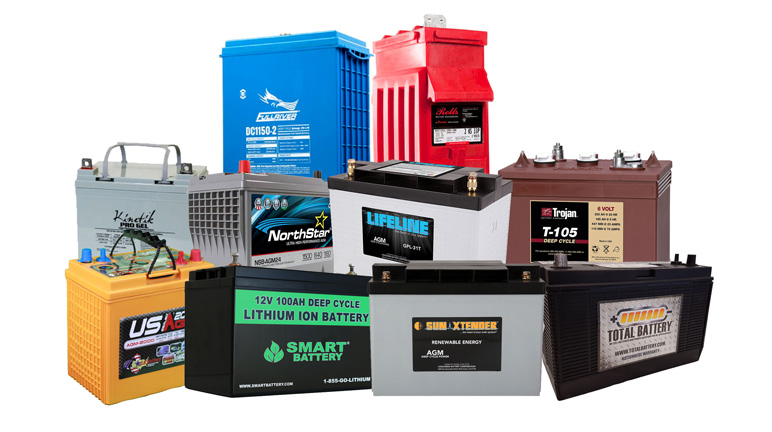DEEP CYCLE vs AUTOMOTIVE
Deep cycle batteries are used to power fish finders and trolling motors on a boat and radios or lights in an RV/camper and are designed differently than the battery you use to start your car. The automotive battery in your car is asked to deliver only short bursts of energy to start your auto and then the alternator takes over, providing the electrical power to run the car and recharge the slightly discharged battery. A deep cycle marine or RV battery, on the other hand, is asked to go through many deep discharges. Often, that battery is completely discharged before it is recharged. This is called “deep cycling.” Timely and proper care of your Marine/RV Batteries will ensure trouble-free operations.
Day to Day Maintenance
The following 4 steps should be followed in maintaining your marine/RV Battery during seasonal usage:
- Recharge deep cycle batteries as soon as possible after use. Allowing batteries to sit in a discharged state for a prolonged period of time is damaging to the future capacity of the battery.
- Prior to recharge be sure the electrolyte level within each cell is at a point slightly below the split ring splash barrel (about 1/8″ below this point). If water has to be added, deionized or distilled water is recommended; however, any water suitable for drinking is preferred to none at all. Never allow electrolyte levels to be as high as splash barrels or as low as plate tops.
- Keep top of battery free of dirt and/or moisture. If battery is kept in a plastic marine battery box, be sure box is clean and dry.
- Clean battery terminals, cable connectors and all accessory connectors regularly (every month or so).
Recharging
To ensure peak performance and long life your Deep Cycle Marine/RV Batteries should be recharged as soon as possible after each use (preferably within 24 hours). Any 10-15 amp charger will be adequate to recharge your batteries. A charger with a timer is recommended to reduce possible overcharge. Overcharging results in grid corrosion and water loss thereby reducing battery life and increasing maintenance (water addition).
Prior to hooking up your battery to the charger read the charger instructions thoroughly and follow steps outlined for recharge.
Check electrolyte level to be sure your battery is ready for recharge.
Use the following Chart 1 to determine approximate times of recharge @ 5, 10, and 15 amps for your deep cycle batteries.
|
Hours of Recharge at* |
||||||
|
Percent |
State of |
Approximate |
5 Amps |
10 Amps |
15 Amps |
|
|
25% 50% 75% 100% |
75% 50% 25% — |
1.225 1.190 1.155 1.120 |
12.4 12.2 12.1 11.9 |
6.0 12.1 18.1 24.1 |
3.0 6.0 9.1 12.1 |
2.0 4.0 6.0 8.1 |
Chart 1
*The above recharge times assume 5% more recharge than theoretical actual, i.e., 105%. This will ensure total recharge of battery plus thorough mixing of electrolyte.
Refer to the chart below to determine state of charge of a battery. If you use a taper charger, i.e., one in which the current drops off as the voltage of the battery rises, recharge times will generally be 4-5 hours more than those shown in the chart. Usually, when a taper charger is used, overnight charging is recommended. At the end of an overnight taper charge the current going into the battery will be approximately 1 amp or less; this will be a good indication that the battery is fully charged.
|
STATE OF CHARGE |
SPECIFIC GRAVITY |
VOLTAGE |
|
100% 75% 50% 25% |
1.265 1.225 1.190 1.155 |
12.7 12.4 12.2 12.1 |
Chart 2
When the battery falls below a 75% state of charge as determined by Chart 2, charge battery overnight according to charger instructions.
After a battery comes off charge, wait a day before checking voltage to determine the state of charge. Final 100% state of charge readings should be 1.265 specific gravity and 12.7 volts.
If this maintenance schedule is followed during prolonged storage, your Deep Cycle Marine/RV Battery will provide peak performance, the next time you use it.
Optimal Extended Storage Procedures
Listed here are six simple steps to follow to ensure that your Marine/RV Battery will be ready for use after extended storage:
- Remove battery from boat or RV. Brush battery terminals and cable connectors with a wire brush. This is an opportune time to perform general “house cleaning” in the vicinity of the battery. Sponge this area clean with a neutralizing solution (1/2 box baking soda to 1/2 gallon water), and dry thoroughly.
- Inspect cables and cable connectors. Repair or replace cable with frayed or broken insulation. Replace broken, cracked or pitted cable connectors.
- Prior to storage, charge battery overnight according to charger instructions
- Store battery in a cool, dry place. The cooler the environment, the slower the self-discharge rate. A temperature range of 40°F to 50°F is ideal. DO NOT store battery in an unheated building or in areas where temperatures will consistently go below freezing (32°F).
- Use a voltmeter or hydrometer to check the state of charge every six to eight weeks.
NOTE – When using a hydrometer, be sure to temperature correct all readings.
Refer to Chart 2 above to determine state of charge of a battery.
If this maintenance schedule is followed during prolonged storage, your Deep Cycle Marine/RV Battery will provide peak performance, the next time you use it.
Remember a battery is a perishable commodity. If maintained properly, it will provide years of trouble-free service.


